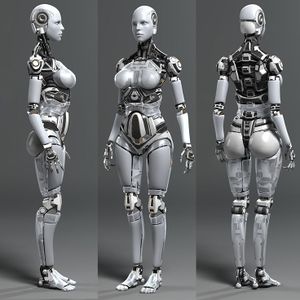
The Mark X Information Assistant or XIA was a project originally developed in the mid 2360's by the Daystrom Institute, though the project was dropped by 2377 due to problems integrating the artificial intelligence unit into the small frame. Later Excalibur Inc began using the existing designs and research to open the project again for testing. Only a few test models exist to date, some are currently being tested at the Blazing Umbra Station by Solas Tempus.
Physical Parameters
Physical parameters can be customized, somewhat, to the task. The final design in testing right now is that of a humanoid android approximately 12cm tall, with built in anti-gravity field generators to facilitate easy movement.
Capabilities
Using a nano-fusion reactor the android is able to both refuel itself with deuterium given a proper fueling station or extract hydrogen from water or the air in order to fuel itself. Though it is best to fill its storage system with deuterium it is not necessary. Using this power the android is able to fly using anti-gravity up to 72 kph with a burst speed of 145 kph for approximately 5 minutes. Bipedal locomotion tops out at 84 kph.
Tools
- Laser Welders (Hands)
- Flash Lights (Hands, Eyes)
- Holographic Projectors (Body, Eyes)
- Isolinear Chip Programmer (Hands)
- Micro-Tractor Beam Emitters (Body)
Communications
- Direct Isolinear Link
- Subspace
- Radio Frequency
- Laser Pulse
- Interplexing Beacon
- Trandsdimensional Beacon
Sensors
- Complete Electromagnetic Spectrum
- Subspace Field Fluctuations
- Light Signs Detection
- Medical Scanners
- Remote Energy Source Detection
Processing
Project Controversy
Under the current laws it is illegal to intentionally develop an AI system, which while the project itself proposes a simple interactive computer, but one that is not sentient, and is not illegal under the current laws. The question has been raised as to if the project itself could promote someone to replace the built in encapsulated computer core with one that contains an AI and thus if the project encourages the development of AI.
Project History
The basic idea was to create a self sufficient but very small android assistant, no more than 9-14cm tall. The small size would allow the android to be easily stored when not in use and when in use it would take up as small amount of space as possible while still being able to act as an autonomous data storage and retrieval device. The earliest models were simply spheres with anti-gravity units in them, which would be designed to float around near a person and relay data via direct link to a PADD, Tricorder, or verbally.
While there were many within the Federation and elsewhere that considered the project to be of somewhat dubious usefulness, the institute proceeded.
Form Factor
While the initial forms were not humanoid, it was discovered that a higher than expected percentage of people in the test groups did not find the device easy to work with and even found it to be disconcerting, a floating autonomous device as a spheroid or cubic design. Various other concepts were designed, some of these broke off and lead to projects such as the Automated Service Robot which is currently used by Solas Tempus. There was also experimentation done with quadrupedal designs for engineering purposes or even six or eight legged designs. These proved to be more difficult for test users to integrate into work flows and even had some purposefully not using them.
Humanoid Form
Psychological and sociological research commenced on how to produce a form factor that would put its users at ease to using it. The Daystrom Institute tried a total of 189 different form factors ranging from spheroid to simple insect designs. Test groups showed the most ability to connect and become comfortable using a humanoid form. The size of the device was still an issue, but the simple AI tests of this form were most successful in producing a psychological connection between the user and the device for optimal use.